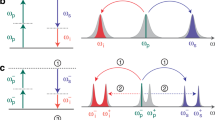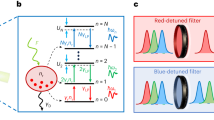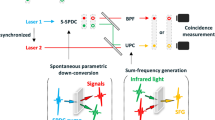Abstract
Photons in a nonlinear medium can repel or attract each other, resulting in strongly correlated quantum many-body states1,2. Typically, such correlated states of light arise from the extreme nonlinearity granted by quantum emitters that are strongly coupled to a photonic mode2,3. However, unavoidable dissipation (such as photon loss) blurs nonlinear quantum effects when such approaches are used. Here, we generate strongly correlated photon states using only weak coupling and taking advantage of dissipation. An ensemble of non-interacting waveguide-coupled atoms induces correlations between simultaneously arriving photons through collectively enhanced nonlinear interactions. These correlated photons experience less dissipation than the uncorrelated ones. Depending on the number of atoms, we experimentally observe strong photon bunching or antibunching of the transmitted light. This realization of a collectively enhanced nonlinearity may turn out to be transformational for quantum information science and opens new avenues for generating non-classical light, covering frequencies from the microwave to the X-ray regime.
This is a preview of subscription content, access via your institution
Access options
Access Nature and 54 other Nature Portfolio journals
Get Nature+, our best-value online-access subscription
$29.99 / 30 days
cancel any time
Subscribe to this journal
Receive 12 print issues and online access
$209.00 per year
only $17.42 per issue
Buy this article
- Purchase on Springer Link
- Instant access to full article PDF
Prices may be subject to local taxes which are calculated during checkout



Similar content being viewed by others
Data availability
The data supporting the findings of this study are available from J.V. (juergen.volz@hu-berlin.de) or A.R. on reasonable request.
Code availability
The code used for modelling the data is available from S.M. on reasonable request.
References
Chang, D. E., Vuletić, V. & Lukin, M. D. Quantum nonlinear optics — photon by photon. Nat. Photon. 8, 685–694 (2014).
Chang, D. E., Douglas, J. S., González-Tudela, A., Hung, C.-L. & Kimble, H. J. Colloquium: quantum matter built from nanoscopic lattices of atoms and photons. Rev. Mod. Phys. 90, 031002 (2018).
Lodahl, P., Mahmoodian, S. & Stobbe, S. Interfacing single photons and single quantum dots with photonic nanostructures. Rev. Mod. Phys. 87, 347–400 (2015).
Birnbaum, K. M. et al. Photon blockade in an optical cavity with one trapped atom. Nature 436, 87–90 (2005).
Dayan, B. et al. A photon turnstile dynamically regulated by one atom. Science 319, 1062–1065 (2008).
Faraon, A. et al. Coherent generation of non-classical light on a chip via photon-induced tunnelling and blockade. Nat. Phys. 4, 859–863 (2008).
Reinhard, A. et al. Strongly correlated photons on a chip. Nat. Photon. 6, 93–96 (2012).
Reiserer, A., Kalb, N., Rempe, G. & Ritter, S. A quantum gate between a flying optical photon and a single trapped atom. Nature 508, 237–240 (2014).
Volz, J., Scheucher, M., Junge, C. & Rauschenbeutel, A. Nonlinear π phase shift for single fibre-guided photons interacting with a single atom. Nat. Photon. 8, 965–970 (2014).
Hamsen, C., Tolazzi, K. N., Wilk, T. & Rempe, G. Two-photon blockade in an atom-driven cavity QED system. Phys. Rev. Lett. 118, 133604 (2017).
Dudin, Y. O. & Kuzmich, A. Strongly interacting Rydberg excitations of a cold atomic gas. Science 336, 887–889 (2012).
Parigi, V. et al. Observation and measurement of interaction-induced dispersive optical nonlinearities in an ensemble of cold Rydberg atoms. Phys. Rev. Lett. 109, 233602 (2012).
Maxwell, D. et al. Storage and control of optical photons using Rydberg polaritons. Phys. Rev. Lett. 110, 103001 (2013).
Firstenberg, O. et al. Attractive photons in a quantum nonlinear medium. Nature 502, 71–75 (2013).
Baur, S., Tiarks, D., Rempe, G. & Dürr, S. Single-photon switch based on Rydberg blockade. Phys. Rev. Lett. 112, 073901 (2014).
Thompson, J. D. et al. Symmetry-protected collisions between strongly interacting photons. Nature 542, 206–209 (2017).
Stiesdal, N. et al. Observation of three-body correlations for photons coupled to a Rydberg superatom. Phys. Rev. Lett. 121, 103601 (2018).
Tiarks, D., Schmidt-Eberle, S., Stolz, T., Rempe, G. & Dürr, S. A photon–photon quantum gate based on Rydberg interactions. Nat. Phys. 15, 124–126 (2019).
Goban, A. et al. Atom-light interactions in photonic crystals. Nat. Commun. 5, 3808 (2014).
Javadi, A. et al. Single-photon non-linear optics with a quantum dot in a waveguide. Nat. Commun. 6, 8655 (2015).
Coles, R. J. et al. Chirality of nanophotonic waveguide with embedded quantum emitter for unidirectional spin transfer. Nat. Commun. 7, 11183 (2016).
Türschmann, P. et al. Coherent nonlinear optics of quantum emitters in nanophotonic waveguides. Nanophotonics 8, 1641–1657 (2019).
Mahmoodian, S. et al. Strongly correlated photon transport in waveguide quantum electrodynamics with weakly coupled emitters. Phys. Rev. Lett. 121, 143601 (2018).
Vetsch, E. et al. Optical interface created by laser-cooled atoms trapped in the evanescent field surrounding an optical nanofiber. Phys. Rev. Lett. 104, 203603 (2010).
Le Kien, F., Liang, J. Q., Hakuta, K. & Balykin, V. I. Field intensity distributions and polarization orientations in a vacuum-clad subwavelength-diameter optical fiber. Opt. Commun. 242, 445–455 (2004).
Lodahl, P. et al. Chiral quantum optics. Nature 541, 473–480 (2017).
Legero, T., Wilk, T., Hennrich, M., Rempe, G. & Kuhn, A. Quantum beat of two single photons. Phys. Rev. Lett. 93, 070503 (2004).
Hennrich, M., Kuhn, A. & Rempe, G. Transition from antibunching to bunching in cavity QED. Phys. Rev. Lett. 94, 053604 (2005).
Nayak, K. P., Le Kien, F., Morinaga, M. & Hakuta, K. Antibunching and bunching of photons in resonance fluorescence from a few atoms into guided modes of an optical nanofiber. Phys. Rev. A 79, 021801(R) (2009).
Duan, L. M., Lukin, M. D., Cirac, J. I. & Zoller, P. Long-distance quantum communication with atomic ensembles and linear optics. Nature 414, 413–418 (2001).
Hammerer, K., Sørensen, A. S. & Polzik, E. S. Quantum interface between light and atomic ensembles. Rev. Mod. Phys. 82, 1041–1093 (2010).
Le Kien, F., Balykin, V. I. & Hakuta, K. Atom trap and waveguide using a two-color evanescent light field around a subwavelength-diameter optical fiber. Phys. Rev. A 70, 063403 (2004).
Goban, A. et al. Demonstration of a state-insensitive, compensated nanofiber trap. Phys. Rev. Lett. 109, 033603 (2012).
Gouraud, B., Maxein, D., Nicolas, A., Morin, O. & Laurat, J. Atom-light interactions in quasi-one-dimensional nanostructures: a Green’s-function perspective. Phys. Rev. Lett 114, 180503 (2015).
Acknowledgements
We acknowledge financial support by the European Commission under the projects ErBeStA (No. 800942) and the ERC grant NanoQuaNt, by the Austrian Science Fund (DK CoQuS Project No. W 1210-N16), by the DFG through CRC 1227 DQ-mat (project A06) and by the Danish National Research Foundation (Center of Excellence Hy-Q).
Author information
Authors and Affiliations
Contributions
K.H., S.M. and A.S.S. made the theory predictions and were responsible for modelling the data. J.H., A.S.P., A.R., S.R., P.S. and J.V. contributed to the design and the setting-up of the experiment. A.S.P. and J.H. performed the experiment. A.S.P. together with S.M. and J.V. was responsible for analysing the data. All authors contributed to the writing of the manuscript.
Corresponding authors
Ethics declarations
Competing interests
The authors declare no competing interests.
Additional information
Publisher’s note Springer Nature remains neutral with regard to jurisdictional claims in published maps and institutional affiliations.
Extended data
Extended Data Fig. 1 Second-order correlation functions for different atom numbers.
The measured correlation functions are shown in blue and the theoretical predictions (see main text) in orange.
Extended Data Fig. 2 Experimental sequence.
First, a MOT and a optical molasses phase are used to load atoms into the nanofibre-based trap (i). This is followed by a 10 ms ramp of the power of the red-detuned trapping field to increase β (ii) and a second molasses phase to re-cool the atoms (iii). To measure the OD of the ensemble, we then sweep the probe laser frequency across the atomic resonance and measure its transmission (iv). The main part of the experimental sequence consists of 350 repetitions of alternating probe and cooling pulses (v). Afterwards, we again measure the OD to check for atom losses (vi), remove the atoms from the trap (vii), and measure transmission through the bare fibre for calibration (viii).
Rights and permissions
About this article
Cite this article
Prasad, A.S., Hinney, J., Mahmoodian, S. et al. Correlating photons using the collective nonlinear response of atoms weakly coupled to an optical mode. Nat. Photonics 14, 719–722 (2020). https://doi.org/10.1038/s41566-020-0692-z
Received:
Accepted:
Published:
Issue Date:
DOI: https://doi.org/10.1038/s41566-020-0692-z
This article is cited by
-
Tunable directional photon scattering from a pair of superconducting qubits
Nature Communications (2023)
-
On the simultaneous scattering of two photons by a single two-level atom
Nature Photonics (2023)
-
Controlled multi-photon subtraction with cascaded Rydberg superatoms as single-photon absorbers
Nature Communications (2021)
-
Guiding light to non-classicality
Nature Photonics (2020)



